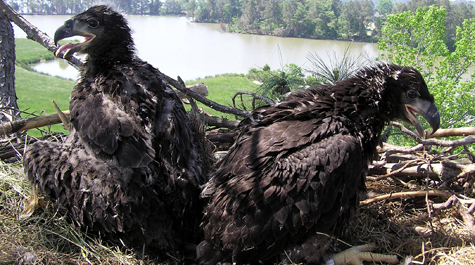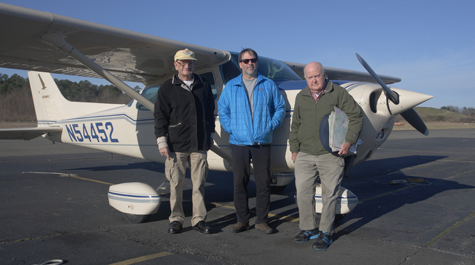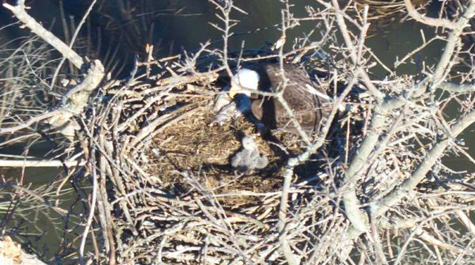Has the James River reached peak eagle?
Every spring for the past quarter century, a Cessna 172 lurches a familiar course over Virginia’s longest river, hovering barely a football field away from the ground.
On board are Captain “Fuzzzo” Shermer, a former fighter pilot, and two William & Mary biologists, Bryan Watts and Mitchell Byrd.
The trio has been counting nesting eagles in Virginia’s Chesapeake watershed since 1993. This year, they are surveying the James River for signs of natural population decline, markers that the tributary has reached peak eagle.
The methodology has remained constant since Byrd first started making the aerial surveys back in 1977. Byrd sits in the copilot seat with a stack of topographic maps, marking down sightings while Watts works as the spotter. Shermer flies the plane at an altitude low enough to see into nests.
“Most pilots won’t fly below about six or eight hundred feet,” Watts said. “They don’t like to get down there. They get nervous.”
{{youtube:medium|gM5F1jhN1Pk, Byrd, Shermer and Watts on a productivity flight}} But 76-year-old Capt. Fuzzzo (the middle “z” is silent, he says) has decades of experience under his belt, as do his passengers. Byrd, who turns 90 in August, has been flying survey routes over the James River for nearly half his life. Watts, the director of the Center for Conservation Biology, began flying with Byrd in the late 1980s.
The whole crew understands that flying too high would defeat the purpose of the trip. They have to survey an area with precision, meaning they need to be high enough to scan a large area at once, but low enough to see inside nests. Watts estimates the team flies at an average altitude of 300 feet, but they often fly lower.
“Once we find a nest, we’ll drop down to check it,” Watts said. “By that I mean drop down to tree level. We have to look into the nest at close range.”
Without those harrowing dips, the team would be unable to monitor one of the most dramatic stages in the history of bald eagle recovery – the point at which the eagle population naturally declines.
“We have a measure of how the population is performing and we’re starting to see that measure drop off,” Watts said. “One of the primary reasons we continue this survey is to try to document how that process plays out. We have an academic interest in what happens when the population reaches the ceiling.”
The survey consists of two sets of flights, one in late February-early March, to document breeding attempts by scouting out new eagle nests and checking the status of known nests. A second set, in late April, documents productivity by counting hatched chicks.
“When we’re flying, I indicate a couple of things,” Watts said. “I’m looking for where the second adult bird -- which is typically the male – is located, if it’s within the area close to the nest and what the age of the chicks are.”
The James River is now one of the region’s most productive areas for nesting eagles. It’s also the only major tributary of the Chesapeake where the eagle population went to zero, Watts explained. The birds have been on a steady path to recovery ever since the federal government banned the use of the pesticide DDT in 1972 and elevated eagles to endangered status under the Endangered Species Act in 1967. Last year, Watts said the team spotted 263 nesting pairs along the James. He expects the count to reach 300 this year.
“Productivity dipped down to a low in the early 1970s and then recovered and now it has sort of flat lined,” Watts said. “What we have been interested in is the back of that. Productivity is going to begin to decline again, but not related to contaminants. It is going to decline due to internal friction within the population, because there’s no room for them.”
Bald eagles can live up to 30 years in the wild and are extremely territorial. They generally mate for life. The combination of territoriality and monogamy is the driving force behind the eagle’s natural population decline, Watts said. Eagles mate in twos, but raising young requires three simultaneous and equally vital jobs.
The female eagle will typically take up the job of incubating the eggs and manning the nest once they hatch. The male eagle is in charge of gathering food and guarding the nest from other predatory birds – two jobs that can’t be done at once. Using data he collected in the late 1990s, Watts is finding that the choice the male eagle makes has changed as the regional eagle population increases.
“The problem is that once the chicks hatch, he is the main provider for the brood,” Watts said. “You can see that he has this tough choice. Do I feed the chicks or do I keep intruders out? What the data shows from the late 1990s up to about 2014 is that his decision has changed over time.”
Up until the late 1990s, the male eagle spent the bulk of his time out foraging. He didn’t need to spend as much time guarding the nest, because there were fewer intruders, Watts said. He was able to provide for the brood and productivity went up. Fast forward to today, the male eagle now spends more time guarding the nest. Watts believes this is due to an increase in intruders. A growing number of eagles are competing for limited space and the rate of productivity is decreasing as a result.
“That fighting that has two outcomes,” Watts explained. “One is it increases adult mortality and the other is that it reduces productivity. Those two demographic processes are what will ultimately bring the population into stability. It’s a negative behavioral feedback loop that will begin to depress the population and it will even out over time. That is sort of one of the benefits of territoriality.”
Eagles are not only adapting to sharing space with each other, they are also increasingly sharing habitat with humans. Watts says one of the most significant adaptations he’s seen during the course of the survey is eagles adjusting to human encroachment. He says he’s seen a dramatic shift in eagle behavior over the past 20 to 30 years.
“Years ago, the birds would not nest around people,” Watts said, “they wouldn’t tolerate disturbance, but increasingly they are. New generations of eagles are beginning to settle in urban areas. They are adapting, which is critical for the long term because as we develop the Bay, we’re not leaving a whole lot of space open for anything else but us.”
When Byrd made his first aerial survey 41 years ago, there were 32 eagle nests in Virginia, Watts said. Now the team can check over 200 nests in a day. As the eagle population recovers, the survey can at times be grueling work.
“When you get on the upper James, we’re hitting nest after nest,” Watts said. “It’s just hitting one after the other and that goes on for hours. I’m talking to Mitchell and he’s recording the data. Things are happening so fast. For somebody that’s 90 years old to keep that pace, it’s pretty impressive. It’s not like the old days, where it was a casual sightseeing trip. It’s not like that anymore.”
Watts says the team now takes each survey season year by year. They are currently training other biologists to continue the flights after they finally decide to pack it in. Watts says the trio has flown over 4,000 hours together throughout the past 25 years.
“Being up in the air gives you a different perspective on the landscape and the species,” Watts said. “We’ve been lucky to be able to do that for so long.”
The Center for Conservation Biology is a joint program of the College of William & Mary and Virginia Commonwealth University.
 Skip to main content
Skip to main content



